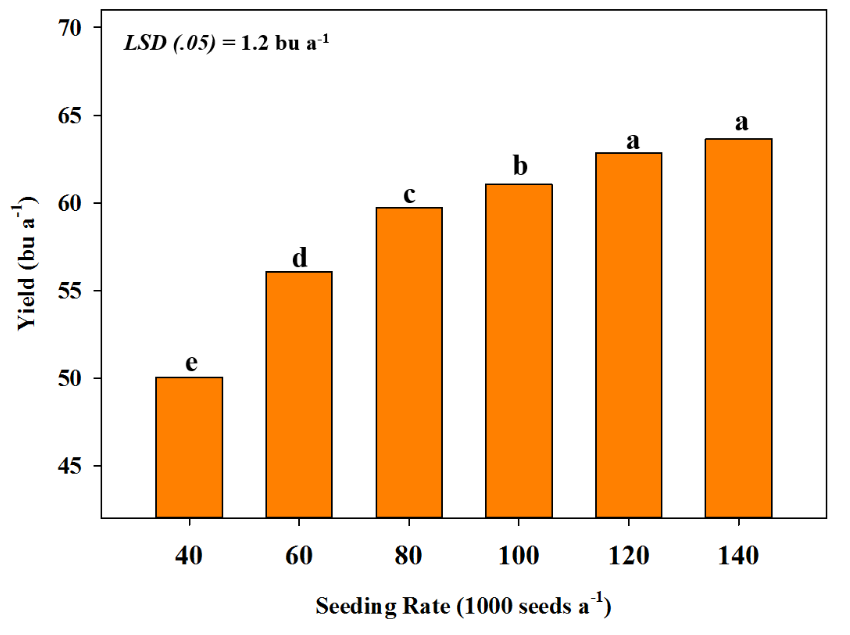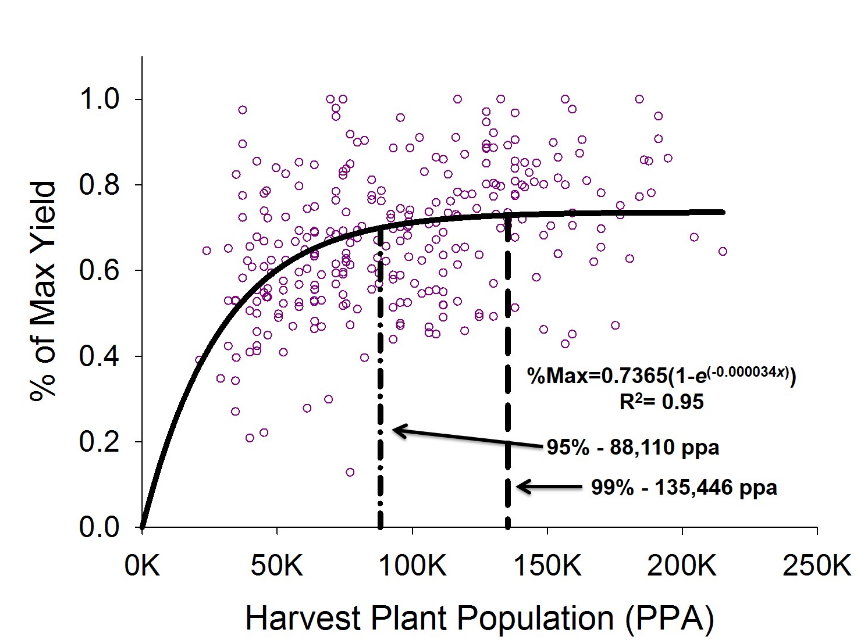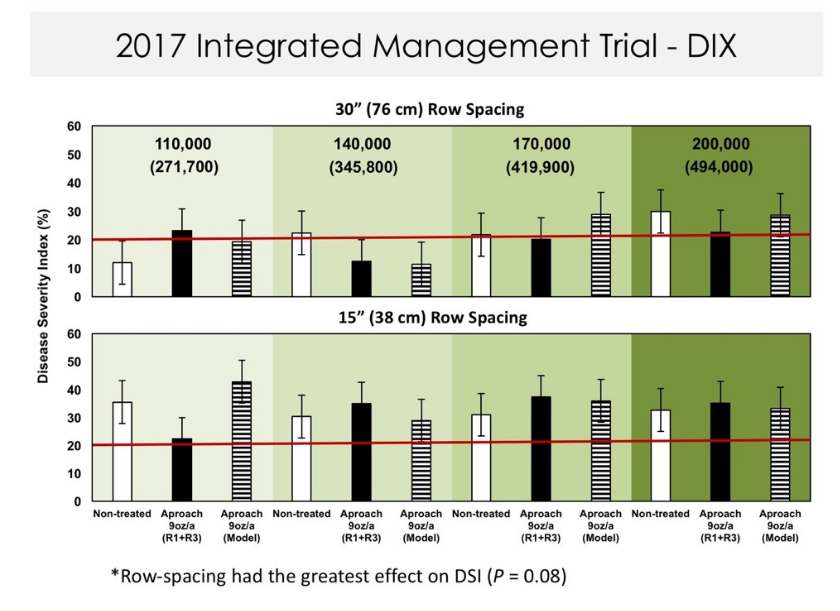ILSOYADVISOR POST
The Soybean Seeding Rate Conundrum
In a bean-pod…
- Use a soybean seed treatment
- Plant less than 140,000 seeds in white mold areas
- Target a final stand of 100,000+ plants in productive fields
- Target a final stand of 135,000+ plants in low productivity fields or areas within fields
Soybean seeding rate is one of the most heavily debated and frankly, in my humble opinion, the most overthought agronomic decision we make in soybean. As a general rule of thumb I recommend farmers purchase a bag of seed per acre (140,000 seed count) and plant that entire bag per acre (140,000 seeds) (Figure 1). Remember your target is to get a minimum stand of 100,000 plants per acre as this population will achieve 100% yield potential in most field environments. This above recommendation holds true in many high yielding field situations.
Figure 1. Seeding Rate Impact on Soybean Yield in WI
We also recommend that growers use a seed treatment on early planted through late May plantings. In WI we have compiled a plethora (that means “a lot” for ISU and UNL graduates) of data showing the economic value and ROI for farmers in our state. We also know that the cost and active ingredient choices across the available seed treatment platforms is vast. Therefore, it is important to know two important things when making this important decision.
- What is my pest and disease history in an individual field so I can choose the appropriate active ingredients.
- What active ingredients choices do I have and what is actually on my seed ?
For more detailed information on our seed treatment work here are a few additional resources to check out!
- Economic Risk and Profitability of Soybean Seed Treatments at Reduced Seeding Rates
- Response of Broad Spectrum and Target Specific Seed Treatments and Seeding Rate on Soybean Seed Yield, Profitability and Economic Risk
What seeding rate should use on less productive fields or areas within fields?
This question is an active area of research in many labs including ours, so specific recommendations may change over the next year. Our current data suggests that we need ~135,000+ plants/acre at harvest to achieve 99% of our maximum yield potential in low yield environments. This would suggest that farmers need to be dropping 160 to 170,000 seeds/acre in these situations.
Figure 2. Soybean Yield Response to Harvest Plant Population in Low Yielding Environments.
How does white mold change the equation?
White mold continues to be one of the major yield-limiting soybean diseases in northern soybean growing states. Management of most soybean diseases starts with selecting a variety with a good level of resistance to the targeted disease. However, the development of white mold resistant varieties has proven difficult. The result is that resistant varieties can only address part of the disease management puzzle for white mold. An integrated approach using several tactics is needed. Specific agronomic practices can help to manage white mold. Strategies for managing white mold such as variety resistance, changes to row spacing and plant population, and the timely application of foliar fungicides, have often been studied individually. However, it has become increasingly clear that a holistic approach to managing this yield-limiting disease, which combines several of these management strategies, is necessary.
Trials in 2017 examined row spacing (15-inch vs 30-inch rows) and planting population (110,000 to 200,000 seeds/acre) simultaneously at two locations in Wisconsin. In addition, fungicide applied in a conventional two-spray program where applications occur at the R1 and R3 soybean growth stages were compared with fungicide application based on a new white mold prediction model.
In this preliminary research, well-timed fungicide applications and increased row spacing had strong effects on reducing white mold incidence and severity and maintaining yield with disease averaging significantly lower in the 30-inch row spacing compared to the 15-inch row spacing. While soybeans planted in a 15-inch row spacing can generally out-yield soybeans planted in a 30-inch row spacing, disease levels in the 15-inch row spacing were high enough that little yield advantage over the 30-inch row spacing was observed in a high white mold environment. The effect of plant population was not as significant as row spacing. Planting populations over 140,000 seeds/acre resulted in marginally higher disease incidence compared to lower planting populations regardless of row spacing.
These studies need to be repeated to determine if these results are consistent in different environments and locations. However, fungicides can be a valuable component of integrated white mold management. Based on one study it appears that wider row spacing and planting at 140,000 seeds/acre or below in Wisconsin can potentially reduce white mold severity and preserve yield potential in a highly disease-conducive environment. Further research trials are planned for Wisconsin with additional locations being added in Minnesota and across the North Central region in 2018, to produce a robust set of white mold management strategies.
Figure 3. Disease severity index of soybean plots planted in 30-inch or 15-inch row spacing, at planting populations ranging from 110,000 seeds/acre to 200,000 seeds/acre and treated with Aproach fungicide applied in a conventional program or according to the disease risk model, or not treated. Trial was located at the Hancock Agricultural Research Station, in Hancock Wisconsin, in 2017.
Should I Take the Time to Develop Seeding Rate Prescriptions?
The answer to that questions is “it depends”. I would certainly not purchase a variable rate planter for the sole purpose of planting soybean. In our previous work entitled “What data layers are important for variable rate soybean seeding prescriptions” we found soybean seeding rate was a poor predictor of soybean yield within a field. We would therefore not recommend that farmers spend a lot of time building seeding rate prescriptions to capture all the variability across a field. We would recommend that farmers develop simple prescriptions where they plant fewer seeds (140,000 seeds/acre or less) in highly productive and/or white mold prone areas. In the less productive fields and areas of fields, seeding rates should be targeted at the 160-170,000 seeds/acre range.







Comments
Add new comment